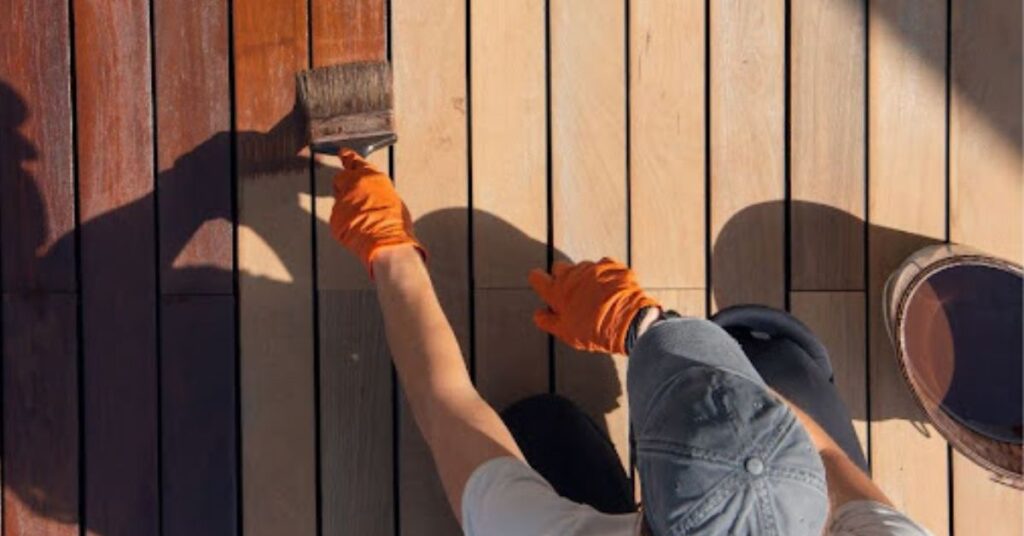If you’re wondering how to stain a deck for a long-lasting, weather-resistant finish, proper preparation and technique are essential. As an experienced deck staining professional in Commerce City, CO, I’ve guided countless homeowners through the process, ensuring their decks not only look great but also withstand harsh weather conditions. Whether you’re considering a DIY project or thinking about hiring exterior house painters, knowing the best techniques can save you time and effort while achieving superior results. In this guide, I’ll walk you through everything from surface preparation to stain application, helping you protect and enhance your outdoor space for years to come.
Why Proper Deck Staining Matters
Staining a deck isn’t just about enhancing its visual appeal — it’s also about protecting the wood from moisture, UV rays, and everyday wear and tear. A well-maintained deck not only looks great but also prevents costly repairs and extends the lifespan of your outdoor investment.
Step 1: Deck Prep for Staining – Start with a Clean Surface
The first and most critical step in how to stain a deck is ensuring the surface is thoroughly cleaned and prepped. Proper deck preparation allows the stain to penetrate evenly and adhere properly, leading to a longer-lasting finish. Here’s how to do it:
- Power Washing a Deck: Use a pressure washer to remove dirt, grime, and any loose or peeling stain. Be mindful of the pressure to avoid damaging the wood.
- Deck Cleaning Solutions: For stubborn stains, mildew, or mold, apply a high-quality deck cleaning solution. Let it sit for 10-15 minutes, then rinse thoroughly.
- Sanding for a Smooth Finish: Once the deck is dry, lightly sand the surface to open up the wood pores. This step is especially important if you’re removing old stain from a deck or if the surface feels rough.
Pro Tip: Skipping proper surface preparation can lead to uneven stain absorption and a shorter lifespan for your deck finish. Taking the time to prep correctly ensures professional-quality results.
Step 2: Choosing the Right Deck Stain – Semi-Transparent vs. Solid Stain
One of the most common questions homeowners ask is whether to choose a semi-transparent vs. solid stain. Both have their pros and cons depending on the look and durability you’re aiming for:
- Semi-Transparent Stain: Offers a more natural look, showcasing the wood grain while providing moderate protection. Ideal for newer or well-maintained decks.
- Solid Stain: Provides a more opaque finish, offering maximum protection against UV rays and moisture. Best suited for older decks or surfaces with imperfections.
Pro Tip: Consider your deck’s age, condition, and exposure to sunlight when deciding between these options.
Step 3: Best Weather for Staining a Deck – Timing Is Key
Staining in the right weather conditions can significantly impact the longevity of your deck’s finish. The best weather for staining a deck is:
✅ Mild temperatures between 50°F and 80°F
✅ Low humidity levels to prevent moisture interference
✅ No rain for at least 24-48 hours after application
Avoid staining in direct sunlight, as it can cause the stain to dry too quickly, leading to uneven coverage.
Step 4: Applying Stain – Best Deck Staining Techniques for a Flawless Finish
When it’s time to apply the stain, using the best deck staining techniques ensures an even, long-lasting coat. Follow these tips:
- Brush for Edges and Corners: Start by using a high-quality brush to apply stain along railings, corners, and hard-to-reach areas.
- Applying Stain with a Roller: Use a roller with a long handle for the main deck boards, ensuring consistent coverage.
- Work with the Wood Grain: Always apply the stain in the direction of the wood grain for a smooth and natural look.
- Avoid Over-Application: Too much stain can lead to a sticky surface and uneven drying. Wipe off any excess to prevent this.
Pro Tip: To achieve the most durable finish, consider applying a second coat after the first layer has dried completely.
Step 5: Maintenance – Keeping Your Deck Looking Its Best
To prolong the life of your deck stain, regular maintenance is essential. Here’s how to keep your deck in top condition:
- Annual Inspections: Check for signs of wear, cracking, or peeling and touch up as needed.
- Routine Cleaning: Use mild soap and water to clean the surface and prevent dirt buildup.
- Reapply Stain When Necessary: Depending on the type of stain and weather exposure, you may need to reapply every 2-3 years.
Mistakes to Avoid When Staining a Deck
Even experienced DIYers can make mistakes that compromise the quality of their deck’s finish. Avoid these common pitfalls:
❌ Skipping proper surface preparation
❌ Applying stain in poor weather conditions
❌ Using the wrong type of stain for your deck’s wood
❌ Overloading the surface with too much stain
By avoiding these mistakes, you’ll ensure a beautiful and long-lasting deck finish.
Final Thoughts: Protecting Your Deck for Years to Come
Staining a wood deck is an investment in both aesthetics and durability. By following these expert techniques, you’ll not only enhance the beauty of your deck but also protect it from harsh weather and everyday wear. If you’re unsure about tackling this project on your own, consider reaching out to exterior house painters to ensure a flawless result.







